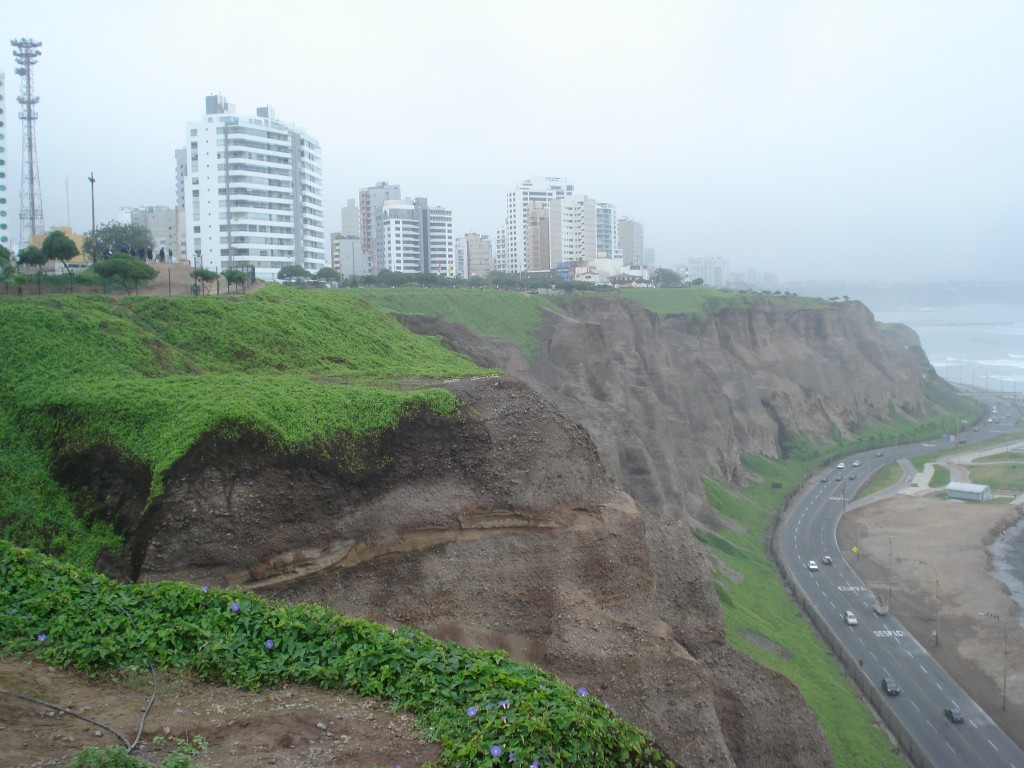
Welcome to a minority of Lima. All these pictures are from la Costa Verde in Miraflores. The tourist track will lead you here, and most CIEE Lima host family placements aren’t far away either.
For this post I draw largely on our Peruvian Social Reality class with Juan Carlos Callirgos, an Anthropology prof at la Católica
Lima is a city that has grown exponentially in the past century, as literally millions of people have migrated from the Andes in search of economic opportunities, better education, and refuge from the violence of Sendero Luminoso in the 80’s and 90’s. The growth was too much for the services available at the time: the city simply couldn’t incorporate that many people into its current structure. There were not enough jobs, not enough schools, not enough hospitals, not enough houses. So the migrants ventured outside the current structure, they made use of the rocky, discarded outskirts of Lima. Most people came with very little, and built new neighborhoods from scratch. People would start with houses of estera (woven mats for walls and ceiling), and would upgrade to wood, to electricity, to plumbing, to cement, to second and third floors as they were able to afford. In the northern district of Independencia, which we visited with our professor Juan Carlos, for example, one can gaze up the hill and see the spacial cronology of migration: the bottom of the hill is a neighborhood of well-established, several-story houses with plumbing and electricity. The further up the hill, the more precarious the living situation, up to the wood and estera houses at the top. I don’t have photos from that day – I didn’t carry my camera. I’ll call it a combination of street smarts and class fears.
The housing improvements in Independencia suggest that those hardworking people have won themselves certain upward mobility. Another notable example is Megaplaza in Los Olivos. It was an abandoned building in one of the more established new neighborhoods. Some folks decided to turn it into a mall. Other folks thought they were crazy, that the people around there were too poor to shop at a mall. The mall started off with less expensive shops, but now Megaplaza houses everything from Saga Falabella to Starbucks, and is the largest commercial center in Peru. Check it out, it’s a nice mall and you’ll probably get better prices than at Larcomar.
On the other hand, migration has been a painful, difficult process for many people. Megaplaza and the rising middle class around it are a success story in one part of the city, but much of the city is still very poor and informally employed. But beyond/linked with the economics are the ethnicity problems.
One of the most surprising aspects of Lima is that it is not a visibly Andean city, not like La Paz, in spite of all the millions who have come to Lima from the Andes. What is the Limeño identity? Whether you can speak of a wide sense of Limeño identity here, I can’t say. Perhaps another day, another post.
The pressure to assimilate is strong: in many ways Lima is hostile to Andean migrants. These informal neighborhoods have been referred to as “invasiones,” and later “barriadas” (not quite neighborhoods). Someone who dresses like they’re from the Andes, or speaks Quechua, might be subject to disparaging looks and remarks. Racism is definitely here, and in many ways less veiled than in the U.S. In most parts of society, insults tend towards race, for example. A standard insult is “Cholo de [insert noun]” or “Cholo [insert adjective]”.
Urban dictionary defines Cholo as the following:
“In Peru: peasant or indian, in a somewhat degrading way because it implies being simple minded. Can also be used affectionately between friends.
In Peru it has no ‘gangster’ connotation.
friends: Que tal cholo! / Habla cholo!
insult: Mira el cholo bloqueando la calle con su burro!
Looking at the media, as another example, the popular “Especial del humor” sometimes features a caricatured woman who is clearly supposed to be a recent Andean migrant.
http://www.youtube.com/watch?v=Rg0PlwunJ2c
I’m blonde, light-skinned and green-eyed. I’m consistently complemented on my looks. This says something about beauty standards. Who’s not getting complements here? I wish I could comment more on the construction of whiteness, I need to start observing and asking more, I think.
Speaking of racism, you could also check out their character Negro Mama
http://www.youtube.com/watch?v=-WznKYKva9w
But the fact is that barriadas, informal neighborhoods, represent the majority of Lima, both in land area and especially in population. If you look on this map (http://www.ubicate.net ), you will see all of Lima. Trace a triangle from Callao, the semi-northern port, down to Chorrillos, the semi-southern coastal district, to La Molina, which is roughly central. As an international student living with an upper-middle class host family in Miraflores, this triangle is the Lima I know. Further than that, either I don’t have an occasion to go there, or if I come up with one people claim it’s dangerous. I’m privileged enough that I don’t have to see the poorer parts of Lima, but they’re still there. Here I sit in a cozy coffee shop bookstore in Miraflores, which is grossly unaffordable to most of the population, and I’m perfectly capable of ignoring that it’s a Third-World country out there. Lima is in some ways a segregated city.
Prospective CIEE students, you might ask yourselves why I tell you this. This entry is a bit of background, among all the entries about how much fun it is to be here (which it certainly is). Similarly, as a CIEE student you’ll probably live with a host family in Miraflores or Barranco or Pueblo libre, and the barriadas will be in the background. But know that they are there to explore.
Peace,
Ian
